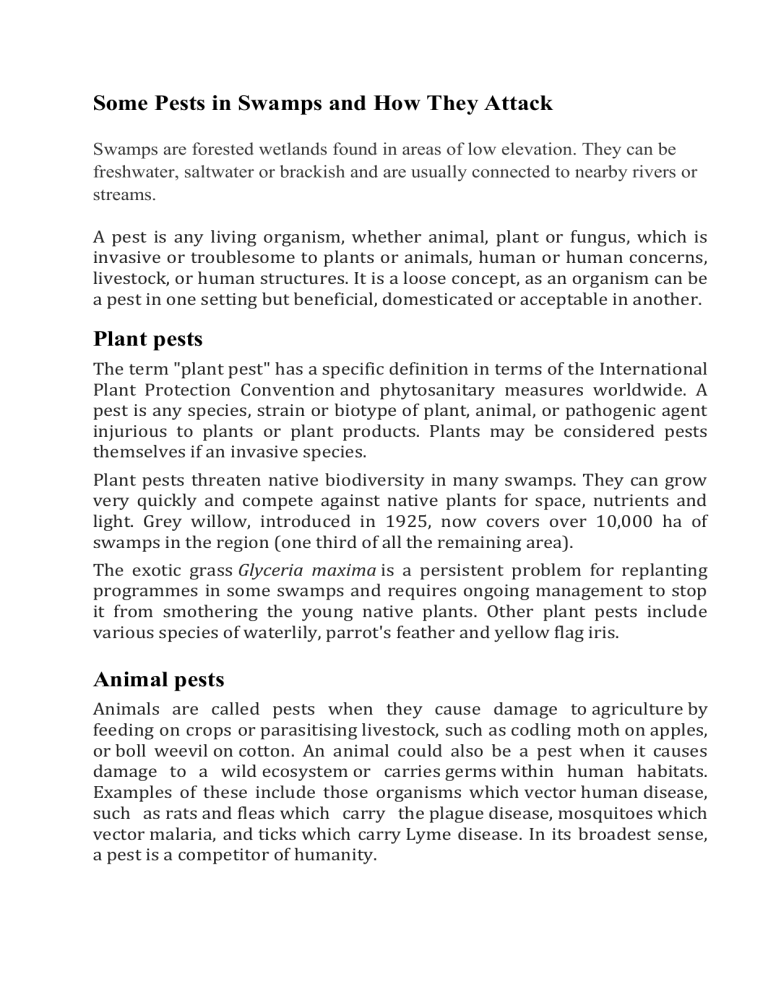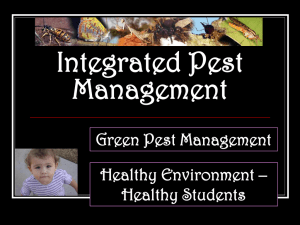
Some Pests in Swamps and How They Attack Swamps are forested wetlands found in areas of low elevation. They can be freshwater, saltwater or brackish and are usually connected to nearby rivers or streams. A pest is any living organism, whether animal, plant or fungus, which is invasive or troublesome to plants or animals, human or human concerns, livestock, or human structures. It is a loose concept, as an organism can be a pest in one setting but beneficial, domesticated or acceptable in another. Plant pests The term "plant pest" has a specific definition in terms of the International Plant Protection Convention and phytosanitary measures worldwide. A pest is any species, strain or biotype of plant, animal, or pathogenic agent injurious to plants or plant products. Plants may be considered pests themselves if an invasive species. Plant pests threaten native biodiversity in many swamps. They can grow very quickly and compete against native plants for space, nutrients and light. Grey willow, introduced in 1925, now covers over 10,000 ha of swamps in the region (one third of all the remaining area). The exotic grass Glyceria maxima is a persistent problem for replanting programmes in some swamps and requires ongoing management to stop it from smothering the young native plants. Other plant pests include various species of waterlily, parrot's feather and yellow flag iris. Animal pests Animals are called pests when they cause damage to agriculture by feeding on crops or parasitising livestock, such as codling moth on apples, or boll weevil on cotton. An animal could also be a pest when it causes damage to a wild ecosystem or carries germs within human habitats. Examples of these include those organisms which vector human disease, such as rats and fleas which carry the plague disease, mosquitoes which vector malaria, and ticks which carry Lyme disease. In its broadest sense, a pest is a competitor of humanity. Deer, rabbits, hares, and pigs have become established in some swamps and pose a threat to native plants and animals. Rats, cats, possums, hedgehogs and mustelids are also found in most swamps. They kill native birds especially during the breeding season when incubating birds are often reluctant to leave the nest. Young chicks and eggs are also taken, as are other native animals such as bats, lizards and insects. Exotic fish such as koi carp and rudd affect aquatic vegetation through grazing. They also affect water quality by stirring up sediments as they feed. Find out more about pest fish in the Waikato region. Some Pests in Swamps Mosquitoes Mosquitoes are found all over the world, with the exception of Antarctica. These blood-sucking insects lay their eggs in standing water, making swarms of mosquitoes commonplace in swampy areas. The bite from a mosquito can cause severe itching, and mosquitoes are a major culprit in the spread of diseases such as malaria, yellow fever and West Nile virus. Only female mosquitos suck blood, which it uses to nourish its eggs. Otherwise male and female mosquitos feed on plant nectar. Dragonflies The dragonfly, identified by bright colors and two pairs of wings, is one of the world's oldest species of flying insects, found in swamps all over the planet. Prehistoric dragonflies once grew to have wingspans as broad as 2 feet; however, modern dragonfly wingspans top out at about 5 inches. Dragonfly larva are aquatic, living in the water for up to two years before taking flight. Adult dragonflies are expert hunters, dining primarily upon mosquitos that they catch with their feet in midair. Water Striders Gliding along the surface of standing swamp water are numerous species of water strider. The water strider has extra-long back and middle pairs of legs, which the insect uses to float gracefully on the water surface. This swamp bug feeds upon other dead insects it finds floating on the water, including injured dragonflies. The water strider uses short front legs for catching prey, middle legs to propel himself, and rear legs to steer. The insect is a popular meal for perch, bass, bullfrogs and salamanders. Other Bugs Many other bugs can be found in the swamps of the world. A large number of butterflies and moths reside in swamp habitats. Various species of beetles, cicadas, toad bugs and biting flies reside in swamps. Pill bugs, also known as sow bugs, are common to swamps. These bugs belong to a family of crustaceans that have evolved to live completely on land. Arachnids such as spiders, harvestmen and ticks inhabit swamps. EFFECTS Pest species are commonly recognised, both nationally and internationally, as a threat to swamps. In particular, pest animals can have a range of negative impacts on swamps, including: habitat degradation (e.g. spreading weeds and reduced amount and quality of water) competition with native fauna for food and shelter direct predation on native fauna poisoning native animals (e.g. by cane toads) and spreading disease altering ecosystem function.


